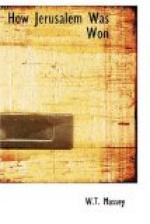A brigade of the 54th Division and the 1st Australian Light Horse Brigade relieved the Scots in the trenches for three nights before the attempt. Every man in the Lowland Division entered upon the work of preparation with whole-hearted enthusiasm. There was much to be done and materials were none too plentiful. Pontoons were wired for and reached Jaffa on the 16th. There was little wood available, and some old houses in Jaffa were pulled down to supply the Army’s needs. The material was collected in the orange groves around the German colony at Sarona, a northern suburb of Jaffa, and every man who could use a tool was set to work to build a framework of rectangular boats to a standard design, and on this framework of wood tarpaulins and canvas were stretched. These boats were light in structure, and were so designed that working parties would be capable of transferring them from their place of manufacture to the river bank. Each boat was to carry twenty men fully armed and equipped over the river. They became so heavy with rain that they in fact only carried sixteen men. The boat builders worked where enemy airmen could not see them, and when the craft were completed the troops were practised at night in embarking and ferrying across a waterway—for this purpose the craft were put on a big pond—and in cutting a path through thick cactus hedges in the dark. During these preparations the artillery was also active. They took their guns up to forward positions during the night, and before the date of the attack there was a bombardment group of eight 6-inch howitzers and a counter battery group of ten 60-pounders and one 6-inch Mark VII. gun in concealed positions, and the artillery dumps had been filled with 400 rounds for each heavy gun and 700 rounds for each field piece. The weather on the 18th, 19th, and 20th December was most unfavourable. Rain was continuous and the valley of the Auja became a morass. The luck of the weather was almost always against General Allenby’s Army, and the troops had become accustomed to fighting the elements as well as the Turks, but here was a situation where rain might have made all the difference between success and failure. General Bulfin saw General Hill and his brigadiers on the afternoon of the 20th. The brigadiers were depressed owing to the floods and the state of the ground, because it was then clear that causeways would have to be made through the mud to the river banks. General Hill remained enthusiastic and hopeful and, the Corps Commander supporting him, it was decided to proceed with the operation. For several nights, with the object of giving the enemy the impression of a nightly strafe, there had been artillery and machine-gun demonstrations occurring about the same time and lasting as long as those planned for the night of the crossing. After dusk on December 20 there was a big movement behind our lines. The ferrying and bridging parties got on the move, each by their particular road, and though the wind




